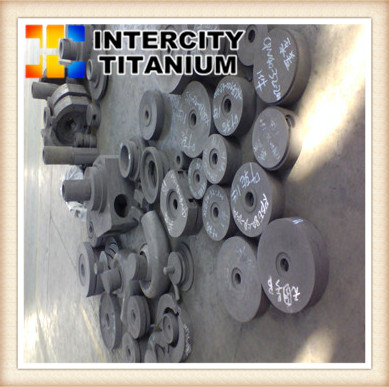First, the vacuum crust melting
Because of its high reactivity, titanium alloys must be melted under vacuum and without being infected with the crucible. The main principle of the vacuum shell meeting is as follows: The negative electrode is poured into the ingot by vacuum melting and the self-consumable electrode formed by the forging process, below the electrode is a copper water-cooled crucible connected to the negative. Before melting, the same kind of titanium alloy scrap or debris is added into the copper crucible as the starting material, and the alloy is melted after the power is activated. Alloy liquid contracts and solidifies with the water-cooled copper crucible to form a layer of condensation on the wall of the crucible. Continue to melt the alloy, the thickening of the shell thickening, reaching a certain thickness, the relationship between the heat balance is no longer thickened and the formation of the molten pool. The crust protects the alloy liquid from reacting with the copper crucible and protects the copper crucible from corrosion by the arc and the molten alloy. The automatic control mechanism causes the consumable electrode to descend and melt at a constant speed, and quantitative cooling water flow maintains the thermal balance of the crucible so that the condensed shell is not melted.
This structure of the vacuum furnace, alloy liquid overheating temperature range is low, increasing the power input is mainly to promote the melting rate, the alloy liquid temperature increase rarely. So, once the current is discontinued, the alloy solution must be quickly poured into the mold because no more heat will be applied.
Second, modeling materials and system methods
Due to the high reactivity of titanium alloy liquid, in order to reduce and eliminate the metal-mold reaction, special modeling materials must be developed.
1. Tamping graphite type
Pounded graphite-based materials are graphite powder, starch, dextrin, petroleum bitumen and water. Stir the above several materials evenly and mix thoroughly into the mixture.
The mold is manually tamped in a detachable box frame and is cured at room temperature for 24 to 48 hours after demoting and then at 200% for 4 to 5 hours, then calcined in a 900% reducing furnace atmosphere for 6 to 12 Hours, slow cooling. Finally, the mold assembly centrifugal casting.
Tamping graphite type can basically meet the demands of titanium alloy castings. Pouring the casting, size 150ram, the deviation is less than 0.75nm, smooth surface. The disadvantage is l (1) high energy consumption, high cost (2) poor flowability of graphite mix, can not use automatic molding machine, (3) low wet strength of graphite mixture, making system core difficult and easy to deformation, (4 Hardening and drying process is too long.
2. Water Glass zirconium oxide (ZrO) Mold
Zircon Sand refractory high (melting point 2426 ~ C), and titanium alloy reactivity; water glass low price, preparation of sand dry high strength. System technology is this : (1) with sand. Sand is dispensed with 25 ml of water glass and 25 ml of water per kg of dry zircon sand, 94% zircon sand, 3.6% water glass and 2.4% water (all by weight). Sand is sand per kilogram of zircon sand with 19 ml of water glass and 69 ml of water. Namely 91.1% of zircon sand, 2.6% of water glass and 6.3% of water; (2) pound water glass sand mold in removable box frame; Shop at 105 temperature for 30 minutes; (4) on the zircon powder coating. Coating Ingredients: 325 mesh zircon powders 0.87kg + l kg of alcohol, (5) Mold in a 250 ~ C ovens drying, 25mm wall thickness required I hour; (6) Box, static or centrifugal casting. This modeling process for wall thickness 5Omm titanium alloy casting is feasible.
3. Precision Shell Casting
(1) with sand. 97% of 80 ~ 100 mesh zircon sand + 3% of 250 ~ 300 mesh zircon powders mixed evenly + 3.8% (weight ratio) of water glass, continuous milling for 8 minutes, and then mixed sand into the dump.
(2) system shells. Preheat the sample in an electric furnace to 240 ° C, remove it and fasten it onto the dump to start the audio oscillator attached to the dump, and at the same time invert the dump, stop shaking after 2 seconds and return to the previous one after 4 minutes . The horizontal sample of the adhered sand was removed and placed in a furnace for heating and held at 250 C for 2 minutes. The sample was then removed from the cured shell and the halves of the shell were bonded with a base tackifier and finally hardened at 250 C for 1 hour.
(3) Static or centrifugal casting.
Third, vacuum centrifugal casting
Due to the overheating temperature of the titanium alloy liquid is low, the flowability is poor and the reactivity is very strong, so a more suitable pouring method is vacuum centrifugal pouring, the pouring chamber is directly installed under the vacuum melting crucible, a centrifugal disc is placed in the pouring chamber, There Jin, alloy liquid from the inclined crucible mouth out along the axial hole poured into the centrifugal plate on the dedicated pouring system poured into the mold. Centrifugal disc centrifugal force created to speed up the alloy flow rate, but also enhance the solidification of the shrinkage. After cooling open the mold to remove the castings, and according to the general method of cleaning castings.









